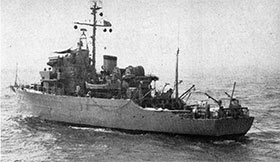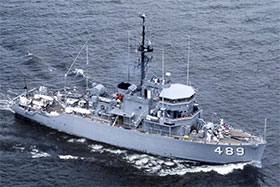Access Free VA Claims Assistance

Free Cancer Guide for Veterans

Find a Top Mesothelioma Doctor

U.S. Navy minesweepers are relatively small naval warships designed to counter the threat of sea mines. The Navy used asbestos to build every type of minesweeper ship. They cleared waterways of mines and opened a safe path for warships to engage in battle during World War II.
Navy ships called minesweepers had important jobs. They helped to clear away dangerous enemy mines from the shore and sea so that other Navy vessels could safely move in.
These ships also served as patrol vessels and conducted anti-submarine warfare maneuvers. Minesweepers were often the first Navy ships sent into a new area before battleships and aircraft carriers arrived. This allowed bigger ships to do their jobs without worrying about mines.
After the First World War, the U.S. wanted to make sure sea mines wouldn’t cause too much damage in a battle. So, they built and launched USS Lapwing (AM 1) in 1917 and it was ready for use by 1918. It was named after the lapwing bird because of its slow, irregular flapping flight and its shrill wailing cry. It was the first of 521 ships with the designation AM.
Where was asbestos in your Navy ship?
Today, the only active minesweeper class is the Avenger class, which is a part of the MCM ship designation. In January 2022, the U.S. Navy was operating eight active Avenger-class minesweepers.
Modern ships are made of steel, but the Avenger class was special. Instead of steel, it had a wooden hull that was covered in fiberglass. This type of construction helped these ships avoid setting off sea mines.
From the Great Depression to the Vietnam War, the U.S. Navy used asbestos to build every type of minesweeper ship.
Asbestos is lightweight and can withstand fire and high temperatures. It was used to insulate engine boilers and other areas that experienced high temperatures. It was also used to cover steam pipes, as packing material, felts, pads and gaskets. According to a list of materials used in Navy boats, over 300 different parts had asbestos as one of the main ingredients.
These asbestos products can get worn out or become disturbed from regular use, leading to the release of tiny fibers into the air. These fibers can cause mesothelioma cancer and other illnesses related to asbestos.

We have assisted several Navy veterans exposed to asbestos aboard minesweepers during their service who developed asbestos-related lung diseases and cancers, including mesothelioma. We can help veterans understand how they were exposed which can be used to pursue benefits from the VA and if applicable, from legal claims.
Asbestos was widely used in many places on minesweepers, such as boiler rooms, engine rooms, and even crew members’ sleeping quarters. Any U.S. Navy veteran who spent time on these ships could have been exposed to asbestos, which can cause illnesses later in life.
I grew up wanting to be in the Navy, probably since I was 12 years old. I was proud to be there, proud to serve. It was fun, too. It took me around the world three times. I never thought about any long-range danger.
People who built ships and those who kept them running may have had a greater chance of exposure. Painting, fitting pipes, electrical work, welding, plumbing, insulating and repairing exposed workers.
Access Free VA Claims Assistance

Free Cancer Guide for Veterans

Find a Top Mesothelioma Doctor

Despite the U.S. Navy’s efforts to reduce the overall amount of asbestos and the number of asbestos-containing products aboard its ships beginning in the 1970s, prior widespread use of the toxic material has resulted in generations of hazardous exposures.
Archived official documents including repair logs, purchase orders and related letters and memos confirm the considerable use of asbestos products aboard U.S. Navy minesweepers.
Navy veterans are at a high risk of developing mesothelioma because of the amount of asbestos the United States military used. Veterans were exposed to asbestos during the course of doing their jobs.
Documents pertaining to the Lapwing-class minesweeper, USS Tanager (AM 385), confirm the use of asbestos mittens on board to protect workers’ hands from high temperatures, as well as ample use of asbestos insulation in a number of ship compartments, including vermiculite insulation, which may contain asbestos. Asbestos insulation was confirmed on USS Tanager in the main and auxiliary exhaust, engine trunks, reduction gears, air compressors, a boiler, and a distilling apparatus.
Asbestos use was also described aboard other AM minesweepers, including USS Strength (AM 309), USS Direct (AM 430), USS Avenge (AM 423), USS Peregrine (AM 373) and USS Surfbird (AM 383).

Learn about mesothelioma, asbestos exposure in the military, top treatment options and more.
Get Yours NowMinesweepers are designed to sweep the seas of various types of mines. These ships are equipped with tools to effectively detonate enemy mines to secure a safe travel path for merchant ships and war ships.
These ships made their debut in the First World War, but their role was minimal. During the years leading up to World War II and during the war, they really began to make an impact in naval battle. This success did not last long. The Korean War pointed out major faults in U.S. minesweepers and prompted revolutionary minesweeper construction. The result was a fleet of ships that proved successful in the Vietnam War.
Modern minesweepers, the few that remain, are equipped with advanced technology to reduce the chances of detonating mines themselves. They are soundproof to reduce their acoustic signature, which can detonate mines. They are also primarily built from wood and glass-reinforced plastic to reduce its magnetic signature, which also detonates sea mines.
Because U.S. Navy minesweeper construction didn’t start until 1917, the ships didn’t make a significant impact in the First World War and only had a role in the last couple months of the war.
Nonetheless, approximately 30 minesweepers with the designation AM were deployed to clear the North Sea Mine Barrage between the shores of Scotland and Norway to inhibit the movement of the German U-boat fleet. Some ships continued their service of sweeping sea mines through 1919, even after the war ended.
During World War II, many new ships were built and put to use for minesweeping. The U.S. was especially prepared, sending about 480 ships out to search for sea mines!
World War II minesweepers would drag two buoys behind them. These buoys had strong steel cables attached to them that could cut through the strings connecting the mines to the sea floor. Once this happened, the mine would float up and then be destroyed by gunfire from the ship.
The ships were very busy during the war, doing lots of different tasks. They swept up mines, kept watch for submarines, and took care of convoys.
As the Second World War came to an end, the Navy focused its time and resources on developing Navy Aircraft Carriers, but the Korean War prompted President Truman’s acknowledgment of the dangers posed by sea mines and the importance that minesweepers could have in the Korean War. He ordered U.S Armed Forces into battle in 1950, and Mine Squadron 3 was sent to clear enemy sea mines around Korea’s east coast.
To further inhibit southward movement of the North Korean People’s Army, USS Chatterer, USS Kite, USS Mockingbird, USS Osprey, USS Partridge, USS Pledge, USS Redhead and USS Osprey completed a sweep from the port to the approaches and stood their ground.
By the end of the war, 70 percent of all U.S. Navy casualties were caused from Korean mines, and U.S. minesweepers were hit with the wide use of magnetic mines by Communist forces, which were detonated by the magnetic field of the steel-hulled ships. This fault prompted the U.S. Navy to build a new designation of minesweepers to counter North Korea mine threats, which later made a more significant impact during the Vietnam War. These news ships became known as ocean minesweepers, MSO.
As a result of the Korean War, the U.S. undertook major construction of the new MSO series on a large scale. During the 1950s, 65 new ships with MSO designations were built. MSOs had the ability to sweep for moored contact mines as well as bottom magnetic and acoustic mines.

These new ships consisted of three classes; the Agile/Aggressive class with hull numbers 421 to 507; the Acme class with hull numbers 508 to 518; and the Ability class with hull numbers 519 to 522.
In contrast to prior steel-hulled minesweepers that served in World War II, these new ships were smaller and constructed mostly of wood with bronze and non-magnetic stainless steel fittings to minimize their magnetic signature. All of the 1950s-era minesweepers were first equipped with UQS-1 mine-locating sonar, which were later upgraded to SQQ-14 sonar.
During the Cold War, favorable U.S. mine warfare tactics were derived from a European war method that relied on the participation of North Atlantic Treaty Organization (NATO) allies. Two U.S. Navy minesweepers were crucial in these tactics: USS Aggressive (MSO 422) and USS Acme (MSO 422). In the early 1980s, the U.S. Navy began constructing another new minesweeper series called MCM for Mine Countermeasures Ships and were classified as the Avenger class.
These ships were designed as minesweepers and hunter-killers that are able to find, classify and destroy moored and bottom mines and are responsible for clearing mines from vital waterways. MCMs are equipped with sonar and video systems, a remote control mine-denoting device and cable cutters. These ships are built primarily from wood with fiberglass sheathing.

The presence of four minesweepers was vitally important during the Iran-Iraq War, also known as the First Persian Gulf War, from 1980 to 1988, and in Operation Desert Storm in 1990 and 1991 when USS Avenger (MCM 1) and USS Guardian (MCM 5) conducted major MCM operations. USS Lucid is the last surviving U.S. Navy MSO hull, and it is in the process of being restored as a museum piece. USS Hazard remains as the last Admirable-class minesweeper in the U.S.
The current outlook for present and future minesweepers is bleak. In the past 10 years, the U.S. Navy has reduced its number of minesweepers and now only uses Avenger-class ships for these essential duties. Soon, these ships might be replaced by new littoral combat ships that can also help with mine countermeasures as part of their mission gear.
Recommended ReadingYour web browser is no longer supported by Microsoft. Update your browser for more security, speed and compatibility.
If you are looking for mesothelioma support, please contact our Patient Advocates at (855) 404-4592
The Mesothelioma Center at Asbestos.com has provided patients and their loved ones the most updated and reliable information on mesothelioma and asbestos exposure since 2006.
Our team of Patient Advocates includes a medical doctor, a registered nurse, health services administrators, veterans, VA-accredited Claims Agents, an oncology patient navigator and hospice care expert. Their combined expertise means we help any mesothelioma patient or loved one through every step of their cancer journey.
More than 30 contributors, including mesothelioma doctors, survivors, health care professionals and other experts, have peer-reviewed our website and written unique research-driven articles to ensure you get the highest-quality medical and health information.
My family has only the highest compliment for the assistance and support that we received from The Mesothelioma Center. This is a staff of compassionate and knowledgeable individuals who respect what your family is experiencing and who go the extra mile to make an unfortunate diagnosis less stressful. Information and assistance were provided by The Mesothelioma Center at no cost to our family.LashawnMesothelioma patient’s daughter


Munz, A. (2024, August 7). Asbestos on Minesweepers. Asbestos.com. Retrieved April 1, 2025, from https://www.asbestos.com/navy/minesweepers/
Munz, Aaron. "Asbestos on Minesweepers." Asbestos.com, 7 Aug 2024, https://www.asbestos.com/navy/minesweepers/.
Munz, Aaron. "Asbestos on Minesweepers." Asbestos.com. Last modified August 7, 2024. https://www.asbestos.com/navy/minesweepers/.
